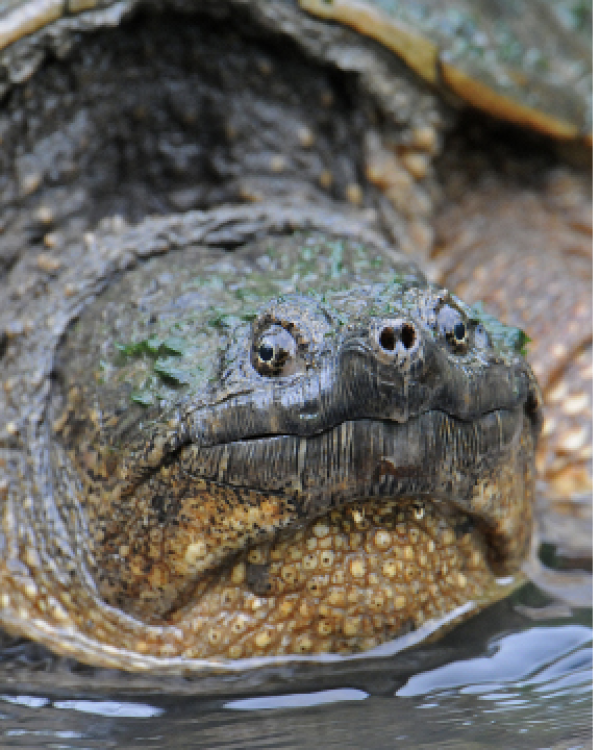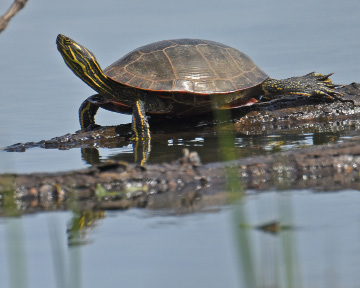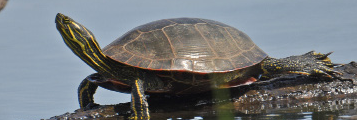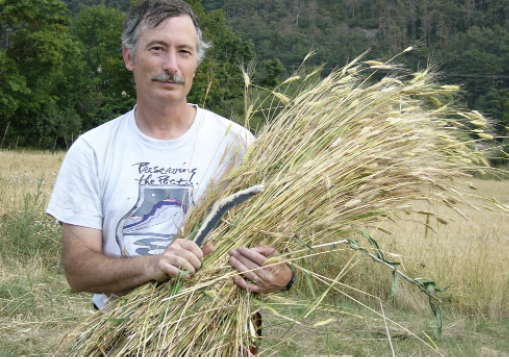The giant trucks crowding past me on I-35 ignore the turtle plodding down the shoulder. Under their wheels, the unfortunate reptile that tries to cross the freeway is no more than a sickening crunch on the way from Tulsa to Des Moines. As a card-carrying “I brake for wildlife” reptile-lover, I feel obliged to rescue turtles when I can stop safely, but I have begun to wonder about the implications of my kindly impulses.
Many Midwestern miles pass beneath my wheels each year, and neither the prairie nor its inhabitants are the flat and bland stereotypes imagined by some Americans. The tribes of turtles are more limited than those of people, but just as the farmer is different from the banker, and the teacher, and the plumber, turtles too require local knowledge and diplomacy. Soft-shelled turtles are parochial. They stick to their rivers, and rarely cross dry land. Snapping turtles wander a lot, up the bank of pond or river, across the golf course or pasture, down the lane, and onto the highway. When you try to help them, they are never grateful, and require careful handling. I am told that dragging them off the asphalt by their tails may damage their spine, and they should be picked up by gripping the back of the shell with the tail between your fingers, or between your hands if they are large enough to require two. Of course it is not always that easy. Even knowing that most snappers are less aggressive than stories have it, those finger-lopping jaws still scare me, and a 30-pound antediluvian with the head of a small fierce dinosaur may just have to take his chances without my help. Box turtles, on the other hand, are pleasant little beasts. They never try to bite; some pull themselves in and lock up the box, but others paddle their legs in the air and wave their heads around curiously as you carry them off the blacktop.
In countries less ravaged by pesticides and highways, tortoises are more common. In Turkey, for instance, I worked some years ago with my wife and students on an ethnographic project in the neighborhood of Kastamonu near the Black Sea. We were interviewing vendors in local markets, which required a lot of driving from town to town. Our ethnographic team encountered European tortoises (Testudo graeca) frequently in Turkey, from the sun-baked and tourist-ridden heat of Ephesus to the cool pines of Mount Ida. The tortoises we saw seemed to share our affinity for archaeological sites, although we found quite a few trapped and perishing in ditches and abandoned excavation areas.
We learned that Ephesus was home to the pre-Socratic philosopher Heraclitus, who posited that all things in nature were in a state of flux, but connected by logical patterns. But as we drove away one day from Ephesus, I remembered aloud that the tragic playwright Aeschylus was supposedly killed by an eagle who, mistaking his balding pate for a rock, dropped a tortoise on it to break the shell. According to some, Aeschylus was living outdoors at the time to avoid a prophecy that said he would be killed by a falling object. It is hard to know if Heraclitus would find a logical pattern here.

Photograph: Ken Saunders II
A tortoise’s need to travel for food and mates, and the needs of humans to do the same, leads to a sad but predictable pattern of highways and flattened reptiles. I took my Midwestern habits to Turkey, and we were occasionally delayed when I braked and pulled over to rescue plodding tortoises on small winding roads, somewhat to the dismay of my companions. While they muttered at the unwisdom of my driving practices, I mused on a Philosophy of Life as Expressed by Tortoises:
I wondered: after lugging a tortoise off the blacktop, through the brambles, across a stone wall, and safely into a field, have I really helped it? True, its chances on the highway were not good, at least if it tried to cross. But maybe it needed to go there. Perhaps I preserved it this time, but now the poor pilgrim, fixed in his determination, would only struggle once again to find a hole in the wall, push through the weeds, climb down into the ditch and up the other side, and scrabble onto the road again. In that case, all I would have done was force the tortoise to waste the energy that it could have better used to mate, find food, escape a predator, cover another hundred yards of rough terrain. Quite possibly, a different disaster awaited it in the field—a blind tumble into a deep and inescapable hole, or grinding destruction under a farmer’s plow.
I will never know, as I drive on, the outcome of my interference, or the rest of the tortoise’s story. When humans intervene in natural processes, we do not often do good. But much of life is like that: it is impossible not to affect the lives of those around us. When you act with the best of intentions but without omniscience, do you help or hurt? Sometimes you have no choice but to make the attempt, and hope that if you prevent one disaster, the future that follows will be better, or may at least offer different chances for better.
Turtles are vulnerable in part because they are so well-protected. Like small inoffensive tanks, they trundle through the world protected from most predators, but blind to the perils of man-made habitats. I consider Midwestern box turtles nature’s Houdinis. In spite of clumsy shells, their powerful legs can get them out of all sorts of places, escaping my railroad tie pens, moving mysteriously from the front floor of my car to under the back seat and into gaps in tightly packed luggage. But shells and legs controlled by a very small brain can also get turtles in trouble around humans.
My friend Ken, a biologist who has also kept box turtles as pets, reminds me that while our box turtles behave like my Turkish tortoises, they are actually terrestrial members of the turtle family. More important to us than their taxonomy, box turtles are great for teaching children responsibility with a pretty indestructible animal. You have to dig worms for them, but they won’t die if you forget to feed them for a few days. If you let them wander the house, you have to clean up after them now and then, but there is no smelly litter box or soiled carpet. They don’t bark at the postman or claw the couch. Tortoises are active enough to be interesting, but they can’t dive through the door and vanish up the street while you call their name in vain. Tortoises do get used to humans, enough to stop hiding and expect food, but compared to dogs and cats, turtles are not cuddly or affectionate. Ken’s daughter was found howling one evening with her tortoise firmly gripping her lip. She swore she was not trying to kiss it goodnight; perhaps it was on her pillow and thought her lip was a worm. Best intentions gone awry again? Maybe. Not all is what it seems to be, even for a tortoise.
You know a child is being raised right if he or she is not afraid of bugs and likes reptiles. Everyone should at least be able to recognize the difference between harmless snakes and those you don’t mess with. And everyone should be kind enough to despise the brutes who treat turtles as targets for their driving. Reptiles, like most of us, find themselves in danger more through ignorance than in pursuit of adventure. Extreme sports are foreign to the small mind of a tortoise; Nature has not evolved them to seek thrills. Be that as it may, in the wild, misadventure sometimes brings them to the inescapable bottom of natural ravines and human diggings, as well as moving them to explore the easy open space of a highway. Pet turtles in a house roll down stairs and try to dig through living room corners. My friend Ken’s daughter grew up to be a social worker, and ‘Tort’ became a metaphor in her counseling for the tendency of all humans, and her clients in particular, to work themselves into a dead end, blindly continuing instead of thinking their way out.
One particular tortoise stands out in memory. I often attend a primitive skills event in Missouri, and driving there from Iowa gives me all too many chances to observe the mortal effects of highways on wildlife. When the national speed limit was 55, I could easily identify small animals, not just deer and raccoons. Once I even rescued a tiny kitten in addition to the tortoises I usually stop for. Barreling along at 75 mph, the current speed limit, and dodging the majority who go even faster, it’s hard to be sure what I see.
This particular tortoise was a dark lump I glimpsed beside the highway—unmistakably a turtle, not a rock or tire fragment. On its back, with head and feet sticking out, it was apparently alive. By good fortune (since I am not fanatical enough to risk my life or become a road hazard to effect a rescue), this turtle lay near an exit. Pulling off on the side of the exit lane, I trotted back along the grassy, littered verge the quarter mile it took to stop. The tortoise was in fact alive, lying beside some flapping paper and a crushed Mountain Dew bottle (the drink of choice for slobs, if highway litter is to be believed). But it was not doing well. The passing tornado of a truck’s wake must have scooped it up and flipped it off the road, bouncing across the black rock of the asphalt. The tortoise’s plastron, its under-shell, was shattered, and its hind legs crushed by the impacted fragments. The rounded upper carapace was undamaged, though, and the hardy reptile was still alive. When I picked him up, he pulled his head and front feet into his damaged shell with a hiss, indicating that the hinge on the plastron still worked. With a screw driver and needle-nose pliers from my toolbox I performed rude surgery, prying and pulling the shell fragments back into place. This freed his damaged hind legs, but I shook my head as I straightened the white bone showing through the green skin. Not much I could do about that. The front end of the beast was still going strong, though, and turtles are amazingly tough little critters.
Back in my car again, with the tortoise in a bucket beside me, I considered: should I put it out of its misery, or hope it would recover? Even hurt, it was an attractive little animal, with the colorful patterns of the ornate box turtle, Terepene ornata. The concave plastron told me he was a male, and as humans do, I had already felt a connection, personalized him. In the end, curiosity and sympathy alike impelled me to keep this turtle: I wanted to know what kind of damage a turtle could sustain and still be worth rescuing. If this one recovered, I figured it would be a gimpy turtle, probably not capable of life in the wild, but I told myself I needed a house reptile anyway.

Photograph: Ken Saunders II
When I arrived at my destination, a group of flintknappers and primitive archery experts camped in a county park, I hospitaled my patient in a shaded bucket in the back of my pickup, cooling him with water and washing away leaking blood. I considered superglue for the shell, but the turtle’s own muscles seemed to be keeping everything in place, and his head and front legs went in and out as he occasionally dragged himself around the bucket. He survived the first day, and the night, and a second day. In the evening, I decided to drive to town with a friend for dinner, and figured the turtle would do better with the minimum of bouncing around in my truck, so I left his bucket under a picnic table.
Alas, when I returned, two friends cleaning up the camp had found the turtle, and deciding he was dead, had thrown him into the woods. I fear they will always regard me with suspicion, remembering my turtle-obsessed ranting. I informed them loudly that my turtle had NOT been dead when I left, and I accused them of secretly cooking and eating him. I assured them that if I found one of them wearing a tortoise-shell rattle at the next event, he would be in trouble.
The next morning, I searched the weeds for over an hour, with the repentant help of the guilty parties, but we couldn’t find the turtle. Had he crawled away? Had he been taken by a raccoon? Did we just not see his camouflaged shell? We never found him. My personal suspicion is that he dug himself deeply into the loose leaves, where he probably didn’t survive for long. It’s likely that Nature took its course, regardless of my designs, but I’ll never know what the outcome really was.
Tortoise philosophy: you never do know, really, and even the best intentions can go awry. After I explained all this at length to my captive audience of grumpy anthropologists, trapped while I drove our small SUV along the Turkish roads to and from Kastamonu, someone expressed a wish that I might experience the fate of Aeschylus at our next stop. I didn’t. But if that were ever to happen, would it be a tragedy, or merely the pattern of Nature?


